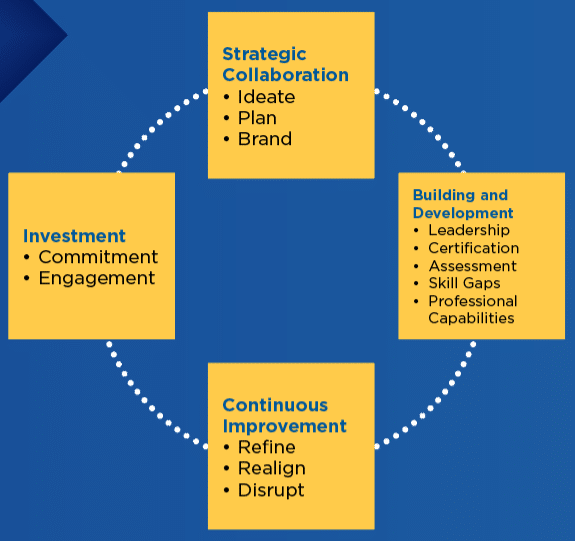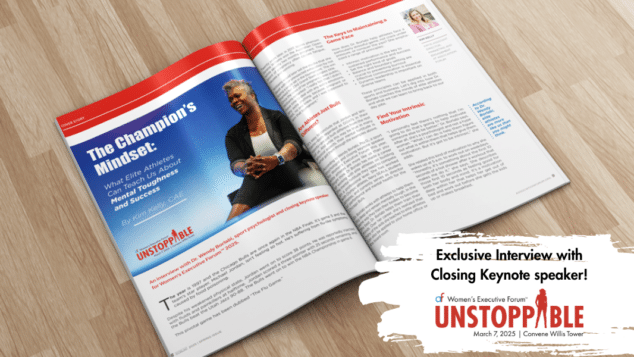Building Leaders Across the Organization

Global pandemics, artificial intelligence, climate change, cultural revolutions, and more have all impacted organizations, creating a need for leadership at every level.
Leadership Skills Required at Every Level
It is imperative that organizations, especially associations and other nonprofits, invest in leadership development for all employees. Organizations hire high performers who will move the mission forward, and in return, employees expect ongoing career development, on-the-job training, and continual skill development. High-performing organizations invest well beyond initial onboarding and see more immediate and long-term results. According to a Harvard Business Review article titled “How to Help Your Team Learn in the Flow of Work,” these organizations embrace “in the flow of work” learning and offer a suite of modalities to support ongoing development. As employees work to build competencies that produce growth for the organization, a focus on building leadership skills will pay back tenfold.
In looking at organizations that focus on ongoing employee development, the National Business Officers Association (NBOA) and the Society of Professional Journalists (SPJ) are two organizations committed to long-term development. NBOA, headquartered in Washington D.C, is a mission forward organization that advances the business practices and operations of PK-12 independent schools. NBOA has been building ongoing intentional staff development processes for staff at every level for several years. James Palmieri, Ed.D., Executive Vice President at NBOA, provided insight into staff development efforts at the organization. With a distributed staff team, NBOA employees meet in-person twice a year for staff development, including a summer offsite retreat and a winter in-office staff planning program.
The Society of Professional Journalists (SPJ), headquartered in Indianapolis, is dedicated to encouraging the free practice of journalism and stimulating high standards of ethical behavior. The SPJ is another organization that ranks staff development as a high priority. SPJ Director of Education, Karyn Nishimura Sneath, FASAE, believes that even in a relatively flat organization, opportunities exist for staff development. Nishimura Sneath noted that “the key drivers for SPJ are growth and changes in the journalism profession that require different skills, knowledge, and abilities than in past years.”
With changes and disruption occurring in every industry and profession, upskilled employees show more leadership, are more productive, have more trust and a positive outlook on the future that helps achieve mission and purpose-driven results.
Adapt, Engage, and Build a Pipeline
Organizations that focus solely on developing leaders at the highest levels, face an imminent threat to competitive advantage. Organizations that have embraced more collaborative and transformative forms of leadership see increased employee engagement and organizational growth. The commitment places the organization on a winning path as it improves employee performance, increases job satisfaction, and creates a pipeline of future leaders.
NBOA exemplifies this in its structured nature of employee development. Two employee leadership committees are responsible for staff development, culture, and climate. Team members who serve on the committees hold two-year terms and include employees from all levels of the organization. The executive vice president leads the Staff Development Committee. The chief learning officer leads the DE&I Committee.
The Staff Development Committee is responsible for year-round development and delivery of employee development programs, professional development programming, climate and recognition initiatives, and partnering with the Staff DE&I Committee. The Staff DE&I Committee is responsible for advancing an inclusive workplace, including developing recommendations for policies, procedures, practices, cultural norms, activities, and evaluating DE&I efforts. Palmieri underscores that “inclusion is critical to the collective success of the organization” and is a core strategic priority for staff, the NBOA Board of Directors, business partners, members and volunteers supported through collective engagement and collaboration.
“It really speaks to the staff culture of NBOA that the only two standing internal staff teams in place are focused on a commitment to being the best association professionals we can be in an inclusive environment where the diversity and authenticity of each individual is supported and respected,” says Jeffrey Shields, FASAE, CAE, NBOA president and CEO since 2010.
The approach taken with SPJ is similar in that all staff have a voice in developing the core strengths of the team. They instituted a more intentional use of professional development plans as a commitment to upskilling and cross-training the staff. Budgetary limitations exist, but focus on personal development and staff capabilities is front and center. The SPJ hosts monthly staff development meetings with one of the pillars focused on newer and younger staff members.
Continuous Learning Builds Confident Leaders
Implementing continuous learning that focuses on core skill development builds confident leaders across the board. Skill development doesn’t just happen serendipitously. Empowering employees, implementing new processes and practices tied to strategic priorities will assist in building a continuous pipeline of confident leaders.
Commitment, investment, and support must begin with executive leadership. It then grows and flourishes with buy-in and personal initiative of employees at all levels. It is important that executive leadership embrace a “flow-through” approach that models the way, embodies organizational goals, and pursues the envisioned culture and climate for leadership growth.
A sampling of core skills, capabilities, and behaviors most needed across every industry include:
- Communication
- Decision-making
- Collaboration
- Culture awareness, humility, and inclusion
- Emotional intelligence
- Coaching and mentoring
It is an ongoing process of learning that builds these skills and capabilities within the organization. The Association of Talent Development (ATD) created a capability model for talent development professionals that serves as an industry-wide tool. As an example of developing inclusion acumen, NBOA held an anti-bias training during a recent staff development retreat and hosted another segment on future trends affecting associations led by Michelle Mason, FASAE, CAE, President and CEO of ASAE.
As organizations continuously look for creative ways to incorporate employee leadership training and development, a hat tip goes to NBOA for developing a learning opportunity entitled “White Space at Work,” based on Juliet Funt’s work and book, “A Minute to Think.” The book explores how busyness is harming productivity and why it is important to take regular pauses. NBOA creatively used the author’s two-minute videos to host facilitated discussions and a companion all-staff reflection session.
Another component of building leadership capabilities is incorporating professional certification and leadership assessment as building blocks for continuous learning and improvement. It is an opportunity for employees to increase their business acumen, look inward, and discover strengths and improvement areas for confident and capable leadership. Both organizations incorporate tools such as the DiSC® Profile (a personality test on work style) and others to build leadership capabilities. Skill gap assessments are also necessary building blocks in this process, especially as shifts continue in the workplace.
Innovation, Process Improvement, and Effective Leadership
Building leadership acumen in employees at all levels builds bench strength. It is a shared responsibility that catalyzes change and requires individual and organizational commitment. Leadership skills develop over time. As a result, employees will generate innovative ideas, collaborate more frequently, and implement process improvements and radical change that move organizations forward.
Organizations taking a holistic approach use a transformational lens instead of viewing leadership as a set of transactions. For example, NBOA uses the five tenets of respect, trust, expectations, accountability, and collaboration as a guide and lens to gauge impact. The SPJ uses change and growth in the journalism profession as a transformational lens to guide their approach to development.
High-performing organizations look inward and outward through environmental scanning, planning, and pivoting. They ultimately adapt their approach to empower employees to lead, flex their learning muscles, and advocate for change that will bring more innovative, efficient and effective ways to serve clients, members, and partners.

What’s Next?
- Add a transformational leadership lens
- Start small or build on current internal capabilities
- Add employee leadership development as a strategic priority
- Build an internal model and brand it
- Build internal teams dedicated to leadership, inclusion and staff development
- Seek and support internal/external training and certification for staff
- Upgrade internal organizational tools and provide access to expert training
- Assess team skill gaps with a supportive structure to impact change
Tags
Related Articles
‘Let’s Get an Intern’: Rethinking Internships in the Association World
With structure and purpose, internships can be more than free labor — they can shape...
Refill Your Cup: Summer Wellness Tips for Busy Professionals
Discover simple, effective ways to recharge this summer so you can show up as your...
The Champion’s Mindset: What Elite Athletes Can Teach Us About Mental Toughness and Success
An interview with Dr. Wendy Borlabi, sport psychologist and closing keynote speaker for Women’s Executive...





